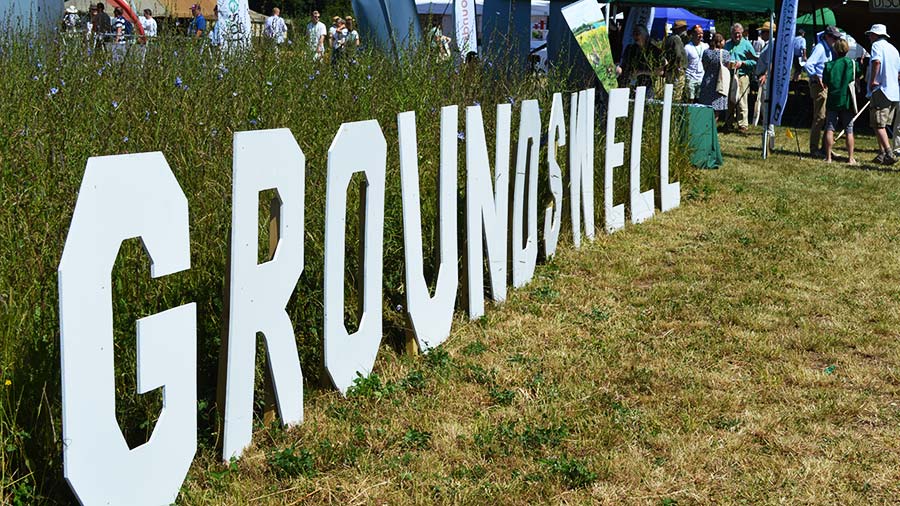Financial rewards of regen farming highlighted at Groundswell
 © MAG/David Jones
© MAG/David Jones The many ways in which regenerative arable farming practices are starting to be rewarded financially were a feature of this year’s Groundswell event.
With supply chains responding to consumer expectations and policy makers keen to hit climate and biodiversity targets, growers were being enticed by both privately and publicly funded schemes – as well as a blend of the two.
New Sustainable Farming Incentive (SFI) actions, which reward fewer interventions and greater diversity, carbon trading schemes based on reduced emissions and soil carbon sequestration, and premium-earning opportunities for crops grown according to protocols were all evident.
See also: Soil Farmer of the Year 2023 goes to Stuart Johnson
Market opportunities
To add to these, long-term natural capital market opportunities were also discussed in various sessions throughout the two days, with farmers being urged to join forces to deliver public goods and nature recovery at scale.
Working together, visitors were told, would allow them to access funding and target lucrative environmental markets that wouldn’t be available to them otherwise.
“The connectivity of landscapes means that, collectively, farmers can deliver more for nature and have greater bargaining power,” said Digby Sowerby of the Environmental Farmers Group.
Blended finance
With new SFI 2023 actions recently announced – including payments of £45/ha and £55/ha for not using insecticides and adopting companion cropping – Janet Hughes of Defra confirmed that privately funded schemes on land in the SFI would be allowed.
“As far as possible, we want to complement private schemes. SFI is designed for mass uptake and for farmers to do as much or as little as they want with actions that are both good for the farm and the environment,” she said.
“We recognise what regenerative farmers are doing and we want to encourage more of it. But they won’t be paid twice for the same thing.”
Defra is also looking at how to help bigger Landscape Recovery projects bring in more green finance and get it to farmers, said Janet.
Private market
Accessing the private market depends on farmers and landowners being able to provide additionality, explained Ivan de Klee of Nattergal.
“A change is required – this market is not about maintenance payments, it wants to buy something else,” he said.
“So if you are already being paid for public goods, such as with an HLS [Higher Level Stewardship] scheme, you need to think about other things you can do.”
For food companies, securing a long-term sustainable supply of produce is key and there is increasing recognition of the risk involved at the farm level as practices change.
As McCain’s vice-president for agriculture James Young explained, working in partnership with the company’s 200 UK potato growers is essential for making progress – especially as McCain’s biggest customer McDonald’s has huge expectations.
Reducing its environmental impact while making farms more resilient and profitable is the twin aim, he said.
“Inevitably, the commercial model will look different – different farm practices come with challenges and costs, so the expectation is that we will pay for that,” said James.
Regenerative crops
One company already paying more for crops produced by regenerative farming is Wildfarmed, which rewards growers for crops grown with greater plant diversity and reduced inputs, according to its protocols.
Often grown with legume companions, Wildfarmed wheat is found in loaves sold in M&S, which come with consumer messaging on its soil and biodiversity benefits.
While many farmers remain wary of the carbon market, adding to the various schemes already out there at Groundswell was a new marketplace that offers landowners the opportunity to generate £100/t of carbon.
Unveiled by Re-generation Earth, the company claimed that its price for carbon credits is the highest currently available and about four to five times higher than other offers.
Even if carbon income is not included, regenerative practices do appear to be opening other income opportunities for farmers, with significant sums expected from the SFI by 2024, reported Amelia Rome of Andersons.
The company’s regen farm model shows good returns in forward budgets, with SFI actions dovetailing well, she noted.
“Moving to a regenerative system may result in a short-term decline in output and require a one-off investment in new equipment, but over time, the physical and financial results improve as soils recover and become more resilient,” she added.

